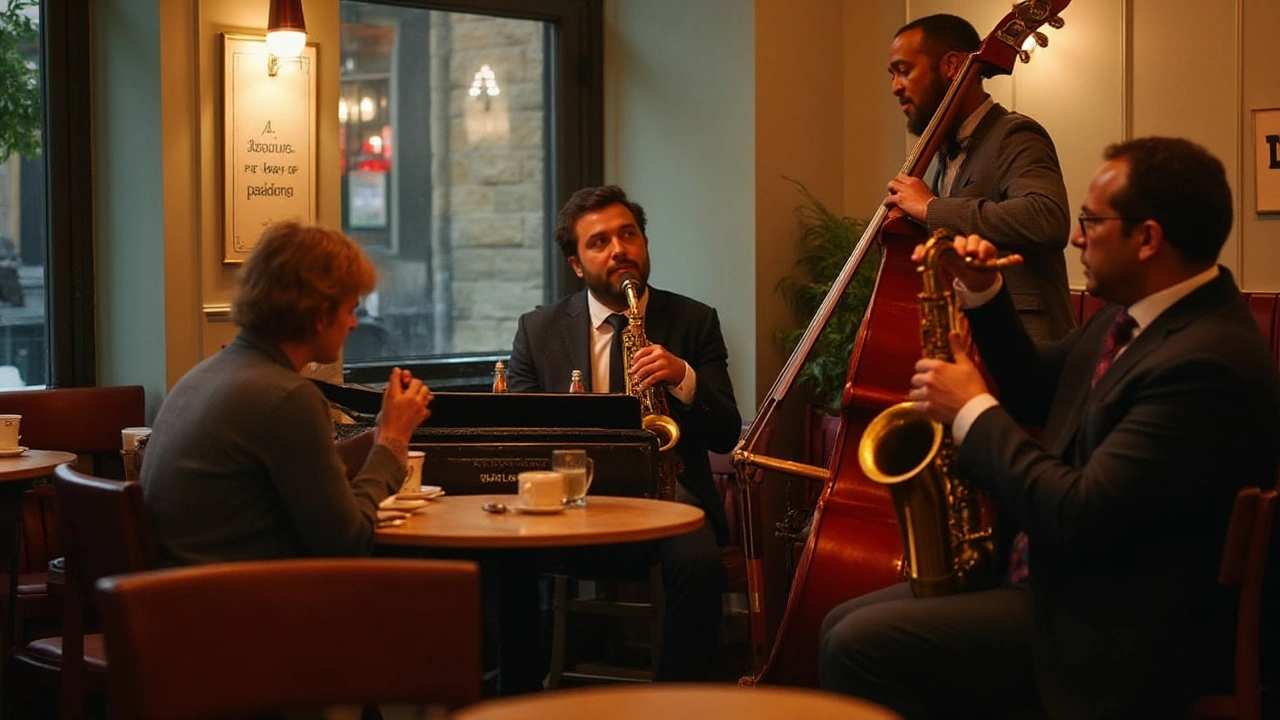Jazz music has long been celebrated for its rich textures, complex rhythms, and soulful improvisations. But did you know it can also be an effective tool for mindfulness and relaxation? Whether you're new to jazz or a longtime fan, understanding how this genre can enhance your mental well-being is a journey worth taking.
From its historical roots to scientifically-backed benefits, we'll explore how jazz can help you find calm in the chaos. Discover tips on incorporating jazz into your daily routine, and learn about some of the best albums and tracks to help you unwind.
Let’s dive into the soothing world of jazz and uncover the secrets to unlocking a more mindful, relaxed you!
- The Science Behind Jazz and Relaxation
- Historical Context of Jazz and Its Calming Effects
- How to Use Jazz for Mindfulness Practice
- Best Jazz Albums and Tracks for Relaxation
- Personal Stories and Experiences
- Tips for Integrating Jazz into Daily Life
The Science Behind Jazz and Relaxation
Understanding how jazz music promotes mindfulness and relaxation begins with exploring the science. The human brain is incredibly responsive to sound and rhythm, and music can influence our emotions and cognitive functions in significant ways. When it comes to jazz, its unique qualities make it exceptionally effective for mental wellness.
One of the most compelling aspects of jazz is its complexity. This genre often features irregular rhythms, syncopation, and a rich tapestry of instruments that engage different parts of the brain. A study published in the Journal of Neuroscience showed that listening to jazz activates the brain's reward system, which is responsible for feelings of pleasure. This activation can reduce stress and promote a sense of well-being.
Another interesting scientific aspect of jazz pertains to its improvisational nature. Unlike other music genres that follow a strict compositional structure, jazz allows musicians to improvise, creating a dynamic and ever-changing listening experience. Exposure to this unpredictability can stimulate the brain, helping to improve cognitive flexibility and emotional resilience. In simpler terms, jazz trains the brain to be more adaptable and responsive.
Additionally, the tempo and rhythm in jazz can have a profound effect on our physiological state. Slower tempos with smooth, relaxing rhythms can activate the parasympathetic nervous system, which is responsible for 'rest and digest' functions. This shift can lower heart rates, reduce blood pressure, and decrease levels of the stress hormone cortisol. The calming rhythms of jazz make it ideal for activities like meditation and yoga, where a tranquil mental state is beneficial.
According to Dr. Daniel Levitin, a neuroscientist and author of 'This Is Your Brain on Music,' 'Music, especially genres rich in improvisation like jazz, can engage complex neural networks, increasing both our emotional and intellectual capacities.'
Moreover, jazz's unique combination of predictability and surprise keeps the brain engaged without causing overstimulation. This balance helps in achieving a mindful state, where one is focused yet relaxed. By keeping the listener in the present moment, jazz promotes mindfulness and helps to break the cycle of stress and anxiety.
A fascinating study conducted by the Mind-Body Wellness Journal found that participants who listened to jazz for just 30 minutes a day reported significant reductions in anxiety and improvements in overall mood. These benefits were attributed to jazz’s ability to modulate brainwave activity, moving the listener into a more relaxed, meditative state.
Both the mental and physical benefits of jazz are complemented by its emotional impact. The improvisational and expressive nature of jazz allows listeners to connect with the music on a deeper level. This emotional engagement can serve as an outlet for expressing feelings and can provide a sense of comfort and solace, which is crucial for mental well-being.

Historical Context of Jazz and Its Calming Effects
Jazz originated in the early 20th century in the African American communities of New Orleans. It blended elements of blues, ragtime, and traditional African music. What made jazz unique was its use of improvisation, syncopation, and a strong rhythmic undercurrent. These components contributed to not only its energetic beats but also its soothing qualities.
As jazz grew in popularity, many listeners noticed its calming effect. During the Great Depression and World War II, people turned to jazz for its ability to uplift spirits and provide a sense of comfort. Its smooth melodies and interactive nature promoted a feeling of connection and relaxation among its audience. The genre eventually evolved, incorporating influences from swing, bebop, and later, fusion genres, but its core elements stayed true to its roots.
An interesting phenomenon occurred during the rise of cool jazz in the 1940s and 1950s. This subgenre focused on softer tones, slower tempos, and fewer improvisational flourishes. Musicians like Miles Davis and Chet Baker brought in elements more conducive to a relaxed atmosphere. Listener reports and anecdotal evidence suggested that cool jazz was particularly effective in alleviating stress and promoting mental well-being.
Studies have also shown that listening to jazz can significantly reduce anxiety levels. According to a study published in the Journal of Music Therapy, patients who listened to jazz reported lower levels of psychological distress and higher levels of relaxation. The rhythm and melody work together to create an environment that soothes the listener's mind and body. It's no wonder that jazz remains a go-to for those looking to unwind.
"Jazz stands for freedom. It's supposed to be the voice of freedom: Get out there and improvise, and take chances, and don't be a perfectionist - leave that to the classical musicians." – Dave BrubeckThe freedom and improvisational nature of jazz can lead to a meditative state. Unlike pre-composed pieces, the spontaneous creation in jazz requires active listening, which can help refocus a restless mind.
In modern times, jazz has found a new life in various contexts from restaurants to coffee shops, and even yoga studios. The ambient setting created by jazz music makes it ideal for mindfulness practices. As the music flows, listeners find it easier to enter a state of meditation and relaxation. Interesting to note, certain jazz compositions have even been incorporated into therapeutic settings, further illustrating its calming effects.
Understanding the historical context and evolution of jazz can help you appreciate its therapeutic qualities. The genre's ability to adapt while maintaining its core elements of improvisation and rhythm makes it one of the most versatile forms of music. Whether you're a seasoned jazz enthusiast or a newcomer, immersing yourself in the soothing sounds of jazz is sure to offer a unique and enriching experience for your mind and soul.

How to Use Jazz for Mindfulness Practice
Integrating jazz music into your mindfulness practice can be incredibly rewarding. The first step is selecting the right kind of jazz. Look for pieces with slow tempos and gentle rhythms. These elements naturally align with the meditative state, making it easier to focus and relax. Legendary artists like Miles Davis and John Coltrane offer tracks that are perfect for this purpose.
Begin your jazzy mindfulness session by finding a quiet space where you won't be disturbed. Sit comfortably, whether on a chair or a cushion on the floor. Close your eyes and start with a few deep breaths to center yourself. As the music begins to play, let it wash over you. Try to focus on the different instruments and rhythms, allowing them to bring your attention back whenever your mind starts to wander.
Deep Listening
Deep listening is a key part of using jazz for mindfulness. Focus on the intricate details of the music: the saxophone's mellowness, the piano's gentle keys, or the subtlety of the brush on the drums. Giving your full attention to these nuances can help clear your mind of distractions and bring you into the present moment. The improvisational nature of jazz means every listen can offer a new experience.
“The beauty of jazz is that it has little to do with the notes being played and everything to do with the ears that are listening.” — Nat Hentoff
Breathing with the Beat
Another technique involves aligning your breath with the beat. Many jazz pieces have a natural ebb and flow. Try inhaling and exhaling in sync with the music’s tempo. This can deepen your sense of connection both to the music and to your own breath, enhancing your mindfulness practice.
Guided Visualization
You can also pair jazz music with guided visualization. As the music plays, visualize yourself in a serene environment. Picture a quiet beach, a tranquil forest, or even floating freely among the stars. Let each note guide your mental imagery, helping you to feel more relaxed and centered.
Creating a Ritual
Consistency is key in mindfulness. Dedicate a certain time each day to your jazz listening meditation. Over time, this ritual can become a cue for your mind to enter a relaxed, mindful state more quickly. Whether it’s during your morning coffee or before bed, find a time that works best for you and stick to it.
By incorporating these practices, you can elevate your mindfulness routine, making it a more enriching and enjoyable experience. Remember, it’s not about perfection but the journey of becoming more present and relaxed. Let the soothing sounds of jazz guide you there.

Tips for Integrating Jazz into Daily Life
Jazz music can be a soothing backdrop to our hectic lives, and there are many ways you can weave it into your everyday routine. One of the simplest methods is to start your day with it. Set your alarm to a mellow jazz track. The gentle rhythms can ease you into wakefulness, setting a serene tone for the day. Unlike blaring alarms, jazz offers a smooth transition from sleep to wakefulness, helping you start your morning on a calm note.
While working, consider playing jazz in the background. Research has shown that ambient music can boost focus and productivity. Jazz, with its lack of vocals and soothing instrumentals, provides an ideal background. It doesn't demand attention like pop or rock; instead, it creates a tranquil environment that can help you concentrate. Try creating a playlist of instrumental jazz tracks that you can play during work hours to see if it helps.
Enjoy Jazz During Breaks
Midday breaks can become moments of mindfulness with the help of jazz. Instead of scrolling through social media or checking emails, take five to ten minutes to sit quietly and listen to a jazz piece. Close your eyes, breathe deeply, and immerse yourself in the music. This can act as a mini-meditation session, reducing stress and refocusing your mind. Over time, you'll find these short breaks can significantly improve your overall mental health.
According to Miles Davis, “Do not fear mistakes. There are none.” His words resonate with the improvisational nature of jazz, which reflects the spontaneity and unpredictability of life.
Use Jazz for Evening Relaxation
Evenings are perfect for winding down with jazz. After a long day, playing a soothing jazz album while you prepare dinner or dine can create a relaxing atmosphere. Opt for softer tunes with smooth saxophones or mellow piano keys. They can help lower adrenaline levels and ease you into a peaceful state of mind. For some, adding jazz to their nightly rituals – like reading a book or taking a bath – has proven to enhance relaxation significantly.
Introducing jazz to your bedtime routine can also improve your sleep quality. Consider a ritual of listening to jazz just before bed. This not only signals your body that it's time to wind down but also creates a comforting auditory environment. Consistent exposure can condition your brain to associate jazz with relaxation and rest, leading to better sleep patterns over time.
Bring Jazz into Social Gatherings
Using jazz to set the tone for social gatherings can elevate the ambiance. Whether hosting a dinner party or a casual get-together, jazz can serve as the perfect background music. Its versatility suits various moods and occasions. For laid-back evenings, choose smooth jazz, and for livelier events, go for more upbeat tracks. This creates a pleasant atmosphere without overshadowing conversations, adding an elegant touch to any event.
For those who enjoy deeper dives into music, consider visiting local jazz clubs or attending live performances. These experiences not only offer a rich auditory experience but also support local artists and the music community. Moreover, live jazz performances often showcase the improvisational aspect of the genre, which can be a thrilling and engaging experience. You might find newfound appreciation and inspiration from watching musicians create their art in real time.
Integrating jazz music into your daily life is an effortless and enjoyable way to promote mindfulness and relaxation. Whether it's starting your day with it, using it to aid concentration, or winding down in the evenings, the gentle rhythms of jazz can enhance mental well-being. By making jazz a part of your routine, you can create pockets of peace and mindfulness amid the hustle and bustle of everyday life.

